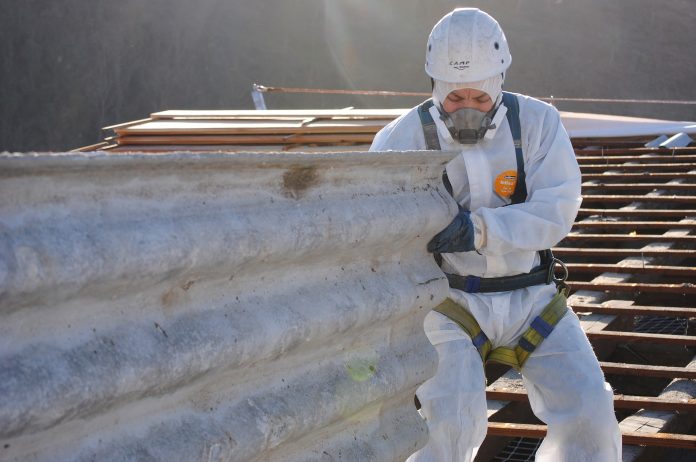Asbestos in over 300,000 public sector buildings continues to put lives at risk. Recommendations to the government for its removal over the next 40 years have been ignored, says Liz Darlison of Mesothelioma UK and Helen Childs, Partner at RWK Goodman
While asbestos imports, supply and use was banned from 1999, it is present in most buildings built before the year 2000. So, with many NHS hospital buildings containing asbestos, national asbestos-related cancer charity, Mesothelioma UK funded a study that aimed to explore the experiences of healthcare workers in the UK with mesothelioma and to develop recommendations for increasing awareness of the risk to healthcare workers.
The ‘MAGS’ study was carried out by researchers at the University of Sheffield. Mags Portman was a 44-year-old award-winning NHS doctor, wife and mother of two young sons. She was diagnosed with mesothelioma from asbestos exposure and died in 2019.
Recommendations from the study included the need to get a more accurate picture of the extent of mesothelioma amongst staff in the NHS (healthcare and ancillary), that awareness of asbestos risk should be added to the mandatory training for new members of NHS staff, and that special consideration should be given to the communication of the diagnosis.

Recently, a Work & Pensions Select Committee report referred to asbestos-related illness as ‘one the great workplace tragedies of modern times’, with the HSE estimating that the total annual cost of death from mesothelioma is £3.4 billion. According to the HSE, asbestos is still in around 300,000 non-domestic buildings and the report recommended a cross-government strategy for the removal of asbestos from public buildings including hospitals, schools, council buildings and more.
The report also stated that ‘asbestos is the single greatest cause of work-related deaths in the UK’ and that the Government must commit to a strategy to remove all asbestos from public and commercial buildings within 40 years – a recommendation welcomed by Mesothelioma UK.
Asbestos consultant, Charles Pickles, gave evidence to the Select Committee stating that 80% of schools contain asbestos and that female primary school teachers now have one of the highest prevalence of mesothelioma as an occupational group.
However, recently the Government confirmed it will not be implementing the Work and Pensions Select Committee’s recommendation to remove all asbestos from public buildings within 40 years.
Mesothelioma: Preventable, but no cure
The Government and the public mistakenly seem to think that asbestos is a problem that’s been solved. Despite the UK finally banning asbestos in 1999, it is still very much present in many of our buildings and so the risk of exposure to asbestos is still with us every day. It only takes the inhalation of very low levels of asbestos fibres to be struck down years later with mesothelioma, a cruel cancer that is not survivable.
We do not have a cure for mesothelioma, but it’s a preventable cancer for future generations with the removal of asbestos from all our buildings. The Government’s blunt rejection of the recommendation from the Work and Pensions Select Committee for a dedicated programme for the phased removal of asbestos is numbing.
Mesothelioma UK would like to invite the decision makers to come and spend a day with one of our nurses or attend a patient support group and explain why the Government has made a choice to not prevent future generations dying of mesothelioma. It’s the asbestos that must go, not more people.
With an annual, preventable, asbestos-related death toll of 5,000, it’s shocking that so few public sector workers, based in buildings that still contain asbestos, receive any training about the dangers it poses, even at low level of exposure.
Research by Howie concluded that teachers and nurses experienced about four and two times higher mesothelioma deaths. (Howie R. Mesothelioma Deaths in Teachers and Nurses in Great Britain. Environ Heal Scotl.2017;29(4):35-37.)
With the continued danger of asbestos exposure, particularly to public sector workers, Mesothelioma UK will press the Government to empower the Health and Safety Executive to deliver better research, measurement and monitoring of asbestos risk, to ensure enforcement of and compliance with Control of Asbestos Regulations.
Advice to prevent mesothelioma cancer
It is crucial that anyone diagnosed with an asbestos related illness seeks advice from a specialist solicitor about the possibility of a civil claim for compensation. Although nothing can adequately compensate for the often-devastating illnesses asbestos can cause, a claim for compensation can include the cost of bespoke medical treatment, including to drug combinations that are not available on the NHS. In order to succeed with a claim, it is necessary to establish culpable exposure to elevated levels of asbestos. A detailed statement taken by a specialist solicitor is crucial in giving anyone diagnosed the best chance of a successful claim.












U.say very low levels , well if that was the case there would be more than 5000 cases a year , what is meant by.low levels all the people I no died of mesothelioma, had day after day exposure , when speaking to top London Dr , he said the u need more than one day if not half England would have it . Sorry very low levels , how long does this mean